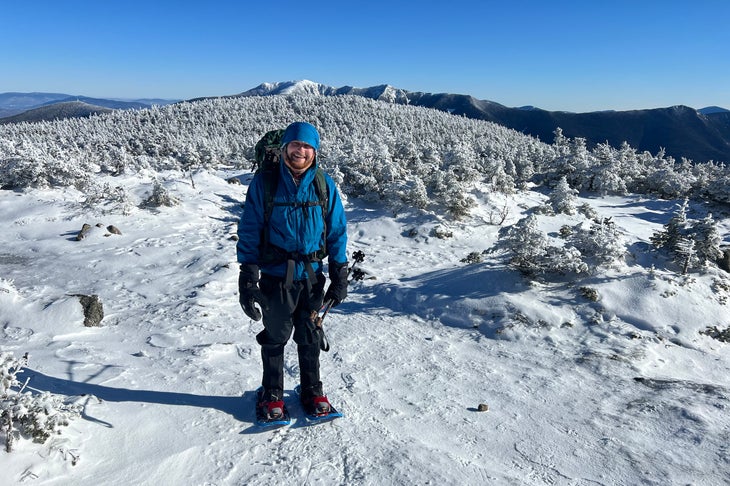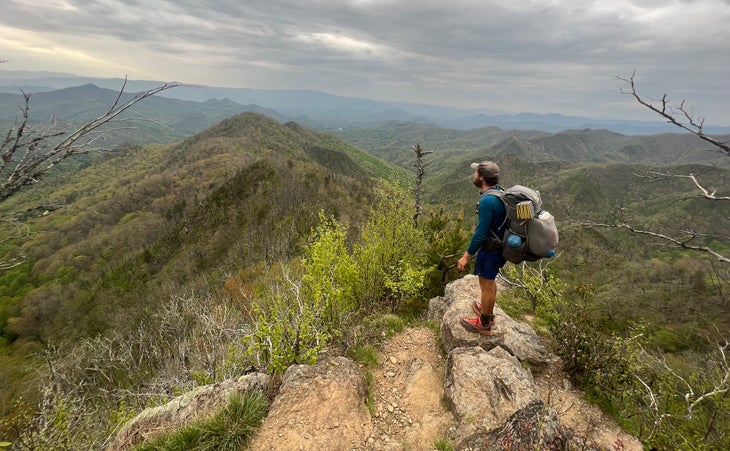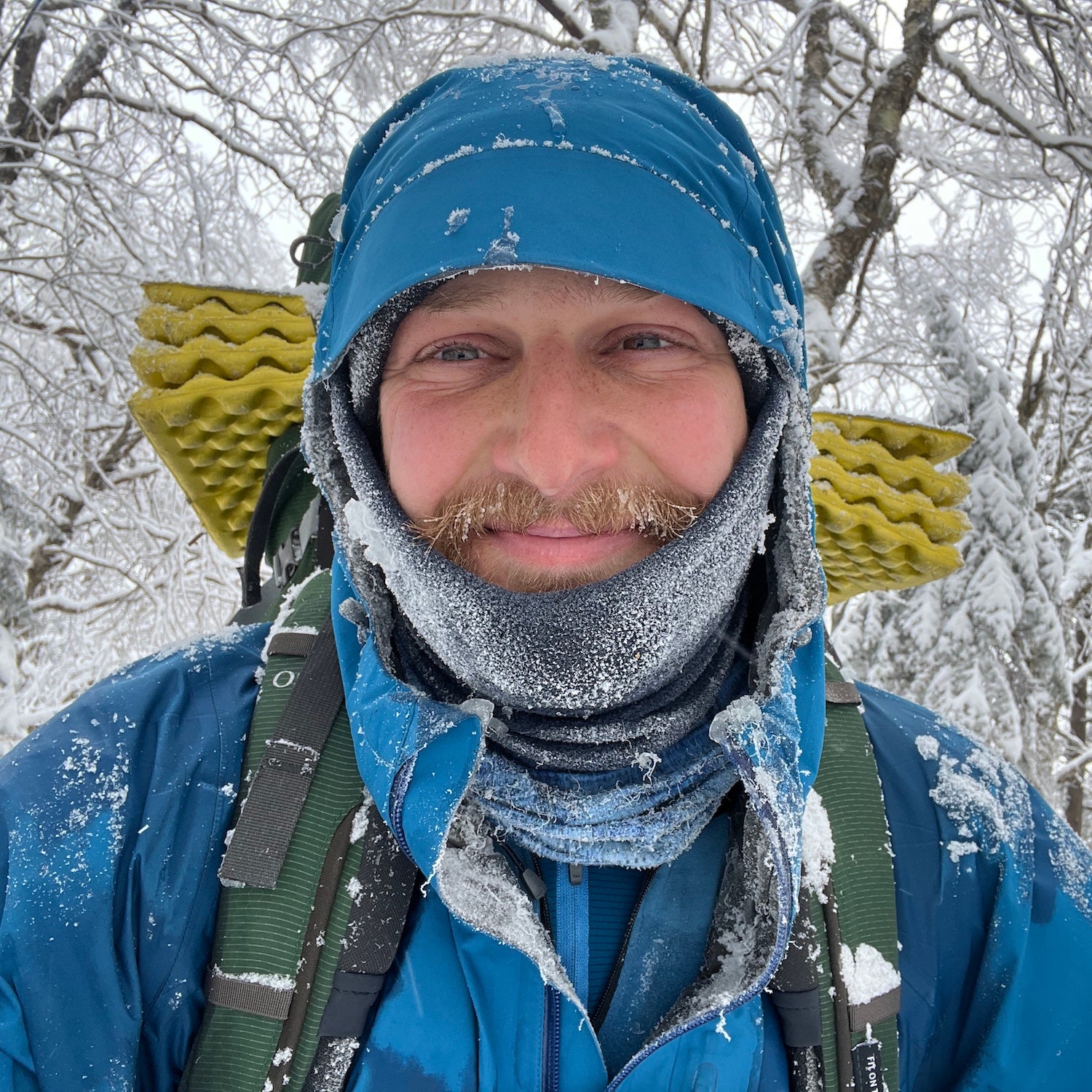Scott Benerofe bailed on his first overnight backpacking trip because he was too cold.
It was mid-March 2016. Benerofe—then a 20-year-old sophomore studying mechanical engineering at Boston’s Northeastern University—had enjoyed a recent string of New England day hikes so much that he decided to invest in gear for something more. In the low-slung mountains of Berkshire County, Massachusetts, he hauled a tent and a down sleeping bag rated for 20 degrees inside a massive Osprey backpack for three miles along the Appalachian Trail and set up camp. An hour after sunset, when temperatures began to dip toward freezing, he panicked, repacked the bag, and headed for the exit.
“I’d done all the research, watched a million videos, unpacked and repacked all the gear in my little dorm room,” Benerofe recalled. “But I was alone, in the dark, and I’d bitten off more than I could chew. I was back in Boston by 11 P.M., and all my friends said, ‘What are you doing here?’”
Six years later, on May 5, 2022, Benerofe completed one of the most challenging, isolated, and frigid feats of American distance hiking: a southbound winter thru-hike of the AT’s 2,200 miles. For the better part of five months, he sometimes contended with windchills of 40 below zero, sustained wind speeds of 50 miles per hour, and arduous hiking through unbroken snow that kept him slogging along at less than a mile per hour. He wore snowshoes across four states, toting a 70-pound pack. At assorted points, he crawled or walked sideways so he wouldn’t be blown off a ridgeline, pushed and shimmed and climbed over frozen trees collapsed across the trail in Vermont, and crossed half-frozen New England creeks while wearing Crocs in December.
But looking back and considering the progress he’d made in a little more than a half decade, he thinks many more hikers could endure this exact challenge—and that long winter hikes like his are more accessible than historically assumed. “I turned around six years ago because I was too cold,” says Benerof, 26. “I’m just a normal guy who likes hiking a lot. Make sure you’re prepared for something like this, but don’t underestimate your abilities.”

Winter hiking on the AT has indeed entered a boomlet, according to the Appalachian Trail Conservancy’s New England regional director, . Trailhead lots that were once empty for that entire season are now overflowing, he says, as hikers seek more solitude, better views, and bigger challenges.
For now, though, a winter southbound thru-hike remains astonishingly rare. In 2019 alone, the Appalachian Trail Conservancy registered about , but it has only ever tracked eight complete southbound winter treks. The most famous such haul almost certainly belongs to Tom Gathman, or the , a mountain of a man and former military sniper turned full-time hiker who has now logged nearly 20,000 miles. During his 2016 trip, he’d post so crusted with ice that it appeared likely to shatter, and that made him look like an extra in .
But Benerofe, known on the trail as Aquaman, is slight, with a crooked grin and kind eyes. His full beard is less a statement than the sign of an unshaven hiker. Before leaving Mount Katahdin in Maine on December 5, 2021, he had only hiked Vermont’s Long Trail in 2016 and the northbound AT three years later. He has a online and he does not want to become a full-time hiker, a YouTube star, or some sponsored adventure icon. In July he’ll begin graduate school at the University of Vermont to become a high school physics teacher, a dream deferred for trails.
A self-professed ordinary person who has now done an extraordinary thing, Benerofe’s success suggests that treks like his could become the next or fastest-known-time quest, once rare endeavors that have exploded in recent years.
“A lot of people have told me how relatable my hike seems, because it’s pretty clear I’m just some dude,” he said. “I’m not famous for hiking. I’m not going to do a new trail every year. I just came out here to have an adventure.”
For most of Benerofe’s youth, his outdoor existence was stereotypical and safe. Growing up in Plainsboro, New Jersey, just outside Princeton, he played several sports. For generations his family had maintained a camp with old cabins in New York’s Adirondacks. They’d head there every summer to canoe on calm waters or make fires with bow drills. But that stuff was reserved for vacation, he thought, believing it only part of life away from real life.
His mom regularly joined family friends on forays into the , where the Delaware River cuts a deep groove into the mountains along the Pennsylvania–New Jersey border and forms a crucial AT crossing. Her trips offered an epiphany: “I realized, Oh, anyone can go backpacking—it’s something I could do if I just had the gear, right?” The night he bailed on backpacking and returned to Boston soon followed, but so did a successful return trip to the same spot with pals a month later. After completing the 273-mile Long Trail that same summer, he adjusted his college schedule so he could graduate early and begin the AT in March 2019.
The moment Benerofe finished the AT, late that July, he confronted one of hiking’s hardest lessons: when it’s over, your life can have a trail-size void, your daily direction and motivation suddenly gone. “There was part of me that just said, Turn around,” Benerofe remembered of reaching the northern terminus. He had fallen in love with backpacking and thru-hiking for familiar reasons—the self-sufficiency of toting everything you need in a bag and moving freely through the woods was attractive, as was the space it gave him to think through daily anxieties.
Without that outlet, however, he suffered. During the pandemic, he worked remotely in upstate New York, living alone and dating someone long-distance. While training for an ultramarathon, a stress reaction in his foot sidelined him for months; the “hiking guy,” as he’d become known to friends, was couch-bound. “I was beating myself up too much over small things, attaching my self-worth to the things I should be doing,” Benerofe said.
One day, eating lunch at his desk and staring blankly at his work screen, the idea struck him—why not hike the AT during the winter? Worried he was again just running away from his problems and anxieties, he made a deal with himself: if he focused on his self-doubt and hatched a life plan for when this hike was done, he could go. “I knew I shouldn’t come out here unless I found a way to be kinder to myself,” he said.
Those mental preparations soon came in handy, just as much as the overnight winter trips he’d started to relish. While headed up Mount Katahdin to reach the trail’s official northern beginning, the weather turned into a whiteout. He’d given himself a clear turnaround time so he knew he’d make it safely off Katahdin’s giant shoulders before dark. He stopped 1.6 miles from the summit, short of the AT’s actual start.
“I told myself, Your journey to Katahdin starts right here. And I have no regrets about that decision,” said Benerofe. “You’re not in charge in the winter; the weather is in charge. You have to honor that, even if my journey was already what some called imperfect.”
And on his sixth day, just after he entered Maine’s isolated and rugged 100-Mile Wilderness, he knew a rainstorm would soon slam the trail, ahead of a deep freeze. He woke up at 2:30 A.M. to trudge eight miles in deep snow to get to a shelter at nine in the morning to hole up while the bad weather passed. He spent the entire day there, bundled in all his layers, grateful to be dry. Several hundred miles later, Benerofe bailed on the famous Franconia Ridge in New Hampshire the day after a blizzard to wait out the relentless windchill in a hostel below.
He could make such hard decisions, he said, because he stopped putting pressure on what his hike needed to be. He was, after all, just a guy who liked hiking, not some superhero. To stay moving, even to stay alive, he had to understand and respect his comfort zone. “It doesn’t make you less of a person to accept that you have limits, and looking for them isn’t such a bad thing either,” he said. “Recognizing that has been really powerful.”
For the Appalachian Trail Conservancy’s Metheny, Benerof’s ability not only to understand when he was almost in too deep are essential for others considering this still novel quest. Modern gear makes such a hike more feasible every year, Metheny says, while our power to share it for an attentive audience makes it more alluring. Yet knowing when to turn back comes with experience and thoughtfulness.
“For a winter thru-hike, you can’t have expectations about time, because of the changing conditions,” Metheny says. “You need more flexible time, days to sit out, days where you’re OK doing only five miles because you’re breaking trail.”

In late April, I met Benerofe in the North Carolina trail town of , about 250 miles from the AT’s southern end in northern Georgia. Off and on for nearly three months, whenever Benerofe had a rest day, he’d relayed me stories about his wintry gauntlet—about keeping electronics charged in subzero temperatures, about wearing goggles while he hiked to keep snowdrifts from freezing his eyes, about the time someone in a town asked him if he needed a calendar.
But it was beautiful now, almost balmy. When Benerofe sat down for lunch, the salt of his sweat left a Rorschach on his blue T-shirt, and his face was damp. Since crossing into Massachusetts, the same state that had sent him away shivering six years ago, the snow and the cold had mostly vanished, so he’d cruised along after passing below the Mason-Dixon Line. He was now a day or so from the 2,000-mile mark, with plans to finish in exactly five months. He was stunned, even proud that the winter slog would take only two weeks more than his springtime hike in 2019.
“My pack got lighter because it was warmer. When it was warmer, there was more daylight. When there’s more daylight, the trail is drier,” he said, beaming between bites of corn bread I’d baked him. “When one thing on this trail started to get easier, everything got easier. I don’t know how much longer I could have weathered that other headspace.”
Still, the recent pace and mileage, he admitted, had taken its toll on his body; he was tired, and more food wasn’t really helping. He was eager to keep at it, though, so he could finally see for himself what was on the other side of thru-hiking. “I want to be able to give my energy to something in a different direction,” he said as northbound hikers a few weeks into their own journeys filed past on the sidewalk. He’d been in their exact position three years earlier and grown so much. “This time, I’m excited for what comes after I finish.”
I called Benerofe a month later, three weeks after he hit the end. He admitted that he was still tired, with some achy spots in his feet and tightness in his legs. Bouncing between his parents’ homes in New Jersey as he waited for school to begin, he felt stuck between stations. But when I asked about folks who might say his hike had been a failure because he’d never reached the summit of Katahdin, it was clear just how valuable his hike had been.
“If someone wants to say I didn’t finish a thru-hike, that’s their decision,” he said, with no edge to his voice. (To be clear, he had climbed Katahdin earlier in the summer, qualifying him for the thru-hike, .) “But if I had summited Katahdin that day, I would have been summiting it for the person who would criticize me in the future, not for myself. My hike was what I wanted it to be. I can’t let a mile take that away.”
In that moment, caring less about people’s perceptions of his journey than what it had afforded him, Benerofe sounded a little less normal and a lot more like himself.


